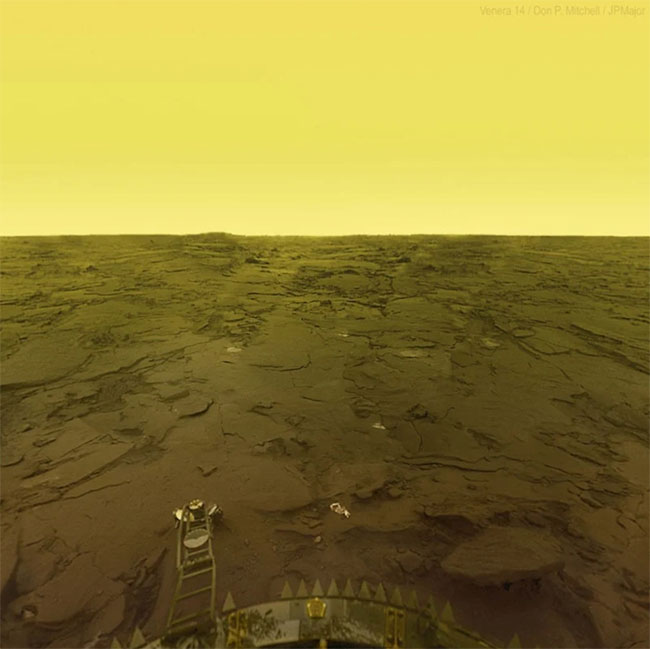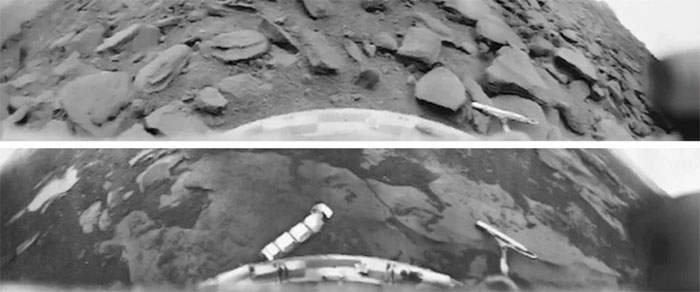Rare photos from the surface of Venus
Venus has a harsh climate, so spacecraft only survive for a very short time after landing.
Venus is considered the hottest planet in the Solar System. With its harsh climate, human exploration of this planet is still quite limited.
While spacecraft are sending more and more images from Mars, high-quality images of the surface of Venus are very limited.
In fact, the best pictures of the surface of Venus were taken by Soviet probes in the early 1980s. In the space industry, four decades is a long time.

Surface of Venus photographed by Venera 14 on March 5, 1982, colorized by Donald Mitchell and Jason Major. (Photo: PetaPixel).
The nemesis of spaceships
Venus is about 200 million kilometers from Earth, 19 million kilometers farther than the distance from Earth to Mars.
Besides its harsh climate, Venus also attracts attention because it is almost the same size as Earth and is also made of rock. Therefore, many people also call Venus Earth's "sister planet" .

Photo of the surface of Venus taken by the Soviet probes Venera 9 and Venera 10. (Photo: Russian Academy of Sciences).
Humans have had missions to explore Venus, but most of them ended in failure. Of the first nine missions, only the 1962 flight using NASA's Mariner 2 probe was successful.
At that time, Mariner 2 flew about 32,000km from the surface of Venus to survey basic parameters.
The first spacecraft to land on Venus was in 1966, when the Soviet probe Venera 3 crashed into the planet's surface after days of no contact.
In 1970, the Venera 7 spacecraft successfully landed on the surface of Venus for the first time and continued to transmit data back to Earth. Two years later, the Soviet Union continued to land the Venera 8 spacecraft on Venus.

Image of Venus taken by NASA's Mariner 10 spacecraft in 1974 (left) and processed image (right). (Photo: NASA).
In 1975, Venera 9 did the same. According to PetaPixel, the Soviet Union sent nine more spacecraft to Mars, the last one, Vega 2, landed in 1984.
NASA has had missions to explore Venus, such as Pioneer Venus 2 in 1978 to examine the atmosphere. To date, the agency has not had a spacecraft successfully land on the surface of Venus.
Harsh atmosphere
According to The Planetary Society, the clearest images of the surface of Venus were taken in the early 1980s by the Venera 9, Venera 10, Venera 13, and Venera 14 spacecraft.
In addition to the black and white and color photos, there are also processed images with straight horizon lines, contributed by the space research enthusiast community.

Images taken by the Venera 13 probe. (Photo: Russian Academy of Sciences).
The heat and atmospheric pressure create Venus's harsh climate , with surface temperatures ranging from 437 to 482 degrees Celsius. Meanwhile, the average surface temperature of Mars is -63 degrees Celsius, making it easier for spacecraft designers.
The atmospheric pressure on Venus is 75 times that of Earth. So if the spacecraft doesn't burn up, it will be crushed. Venera 13 is the probe that holds the record for the longest stay on the surface of Venus, at 127 minutes.
Venus's thick atmosphere makes it impossible for humans to observe its surface from space , at least in the visible spectrum. Therefore, the only way to see the surface of Venus is to land on the ground.

Images taken by the Venera 14 probe. (Photo: Russian Academy of Sciences).
Although no spacecraft has landed on Venus, NASA's Mariner 2 is the first spacecraft to fly by a planet other than Earth.
During the 42-minute survey, scientists discovered many details about Venus, including its extremely hot atmosphere.
NASA is developing DAVINCI, a spacecraft that is scheduled to reach Venus' atmosphere in 2031, with two follow-up missions a few years later. DAVINCI will focus on surveying the planet's atmosphere and surface.
Until then, it will be a long time before humans can see more clear images of the surface of Venus.
- NASA concussion statement about Venus
- NASA wants to bring people to Venus
- Venus is about to be a
- Interesting things about the planet
- This planet may once have brought life
- Venus suddenly turned slower
- New discovery on Venus: Two volcanoes erupting lava!
- The ocean may exist on Venus on Earth about 700 million years ago
- Overview of Venus
- NASA simulates Venus's hellish environment
- NASA captures the first beautiful images of the surface of Venus
- Polar regions are cooler than anywhere on Earth
 Van Allen's belt and evidence that the Apollo 11 mission to the Moon was myth
Van Allen's belt and evidence that the Apollo 11 mission to the Moon was myth The levels of civilization in the universe (Kardashev scale)
The levels of civilization in the universe (Kardashev scale) Today Mars, the sun and the Earth are aligned
Today Mars, the sun and the Earth are aligned The Amazon owner announced a secret plan to build a space base for thousands of people
The Amazon owner announced a secret plan to build a space base for thousands of people